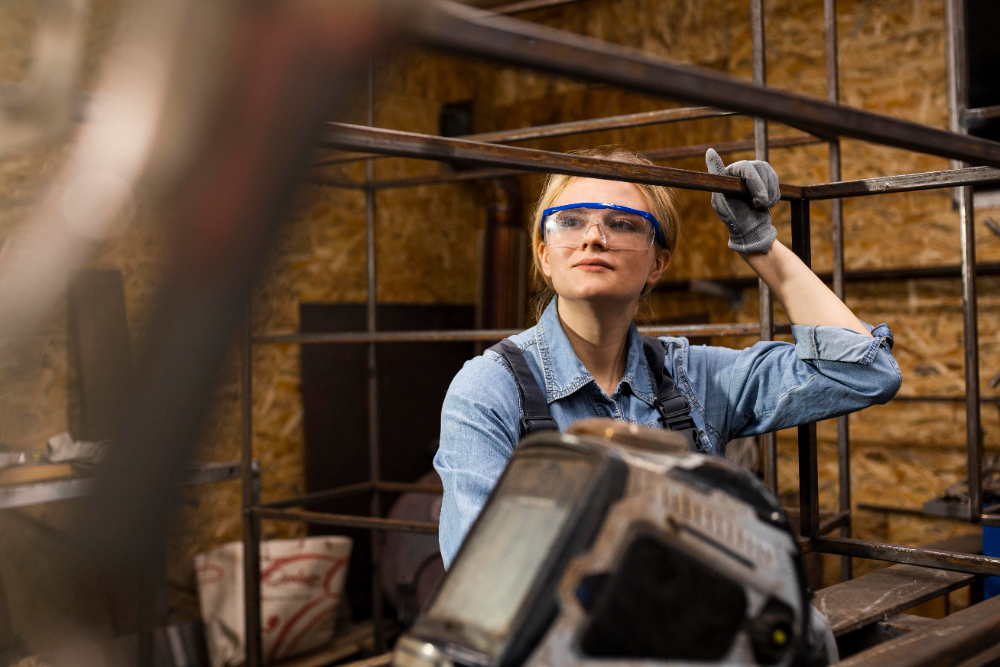If metal bars are known for their durability, versatility, and cost-effectiveness, then you must be thinking “Why do I need to maintain them?”
Whatever you use your metal barn for: storage, livestock, or as a workspace, then proper maintenance is essential to ensure it serves you well for decades. While metal barns require less upkeep than their wooden counterparts, neglecting routine care can lead to issues that compromise their longevity and functionality.
The folks at Lion Barns have created this guide to walk you through comprehensive tips to maintain your metal barn in peak condition.
Inspect Your Barn Regularly
Routine inspections are the cornerstone of maintaining a durable and reliable metal barn. Conduct these inspections at least twice a year, preferably during the spring and fall. These periods are ideal because they allow you to address any damage caused by harsh winter weather or prepare the structure for upcoming seasonal challenges. By consistently inspecting your barn, you can catch minor issues before they escalate into costly repairs. The focus should be on high-risk areas, including the roof, walls, and foundation, as these components bear the brunt of environmental exposure and daily wear.
During an inspection, it’s essential to look for specific signs of deterioration. Rust is a common issue in metal barns, especially in areas prone to humidity or frequent rainfall. Even small patches of rust can spread quickly if left untreated, potentially compromising the structural integrity of your barn. Similarly, loose fasteners, such as screws and bolts, can weaken connections and lead to instability. Dents and cracks, though seemingly minor, may cause water to seep into the barn, leading to leaks and reducing insulation effectiveness.
To ensure thorough inspections, don’t overlook the interior. Use a flashlight to examine hidden or dimly lit areas for signs of moisture, mold, or pest infestations. Moisture inside the barn can indicate leaks or poor ventilation, both of which need immediate attention. Mold not only damages materials but also poses health risks to livestock and workers. Pests, such as rodents or insects, can exploit small openings to enter the barn, causing damage and contamination. Regular and comprehensive inspections enable you to maintain your metal barn’s integrity and functionality for years to come.
Address Rust Promptly
Rust is the most common issue in metal barns, especially in humid or coastal areas. If you spot any rust, act quickly to prevent it from spreading. Use a wire brush or sandpaper to remove the rusted area and then apply a rust-inhibiting primer. Finish by repainting the area with weather-resistant paint that matches your barn’s exterior.
Preventive measures can significantly reduce rust formation. Ensure your barn is adequately ventilated to minimize moisture buildup, and consider applying a protective coating to the entire structure every few years. This coating acts as a barrier against moisture and other corrosive elements, extending the life of your metal barn.
Maintain a Clean Exterior
Keeping the exterior of your metal barn clean not only improves its appearance but also prevents damage. Dirt, debris, and bird droppings can trap moisture, accelerating rust and corrosion. Use a hose or pressure washer to clean the walls and roof regularly, especially after heavy storms or during pollen season.
When cleaning, avoid using harsh chemicals or abrasive tools that could damage the paint or protective coatings. A mild detergent mixed with water is usually sufficient for most cleaning tasks. If you encounter stubborn stains, test a small, inconspicuous area before applying stronger cleaning agents.
Protect the Roof
The roof is one of the most critical parts of your metal barn, as it shields the interior from weather elements. Regularly check for loose panels, damaged fasteners, or any signs of leaks. Clear leaves, branches, and other debris from the roof to prevent water pooling, which can cause rust or structural damage.
Invest in a gutter system to direct rainwater away from the roof and foundation. Clean the gutters periodically to prevent clogs that could lead to water overflow and damage. If your barn is in an area prone to heavy snowfall, remove snow buildup promptly to avoid excess weight that could strain the roof.
Seal Gaps and Openings
Proper sealing is essential to keep your barn weatherproof and energy-efficient. Over time, gaps or openings may develop around windows, doors, or panel seams. These gaps can let in water, pests, and drafts, potentially compromising the barn’s functionality.
Inspect seals and caulking regularly and replace any that show signs of wear or cracking. Use weather-resistant caulk or sealant specifically designed for metal structures. Additionally, check that doors and windows close tightly, and repair or replace any warped or damaged frames.
Control Moisture and Ventilation
Moisture is the enemy of metal barns. Proper ventilation helps regulate temperature and humidity levels, reducing the risk of rust, mold, and mildew. Install vents, fans, or louvers to encourage airflow, especially in barns used for livestock or storage.
Monitor the interior for signs of condensation, particularly on the walls and roof. If you notice excessive moisture, consider adding a vapor barrier or insulation to reduce temperature fluctuations that cause condensation. Address any leaks immediately to prevent water from seeping into the structure.
Pest Control Measures
While metal barns are less susceptible to pest infestations than wooden structures, they are not entirely immune. Rodents, birds, and insects can cause damage or create unsanitary conditions.
Seal any small openings where pests might enter, and keep the area around the barn clean and free of food sources or nesting materials. Store feed and other attractants in sealed containers, and consider using humane traps or deterrents if necessary. For severe infestations, consult a professional exterminator.
Foundation Maintenance
A strong foundation is vital for the stability of your metal barn. Inspect the foundation for cracks, settling, or water pooling around the edges. These issues can lead to structural instability if not addressed promptly.
Ensure proper drainage around the barn to prevent water from eroding the foundation. If you notice significant cracks or uneven settling, consult a contractor to assess and repair the damage. A stable foundation will extend the lifespan of your metal barn and prevent costly repairs down the line.
Reinforce Structural Integrity
As your metal barn ages, it may require reinforcements to maintain its structural integrity. Inspect the framework for signs of bending, warping, or corrosion, particularly in areas exposed to heavy loads or extreme weather.
Replace damaged panels, beams, or fasteners as needed. If your barn has sustained significant damage, consider consulting a structural engineer to determine the best course of action. Regular maintenance of structural components ensures your barn remains safe and functional for years to come.
Insulation and Energy Efficiency
If your metal barn is insulated, inspect the insulation periodically for signs of damage, such as moisture infiltration or pest activity. Damaged insulation can reduce energy efficiency and create an uncomfortable environment for both humans and animals.
Upgrade to modern insulation materials if your existing insulation is outdated or ineffective. Additionally, consider energy-efficient upgrades like reflective roofing materials or solar panels to reduce energy costs and enhance the barn’s sustainability.
Seasonal Maintenance Tasks
Different seasons bring unique challenges for metal barn maintenance. In the winter, clear snow from the roof and check for ice dam formation. In the spring, inspect for damage caused by heavy rains or storms. Summer is an ideal time for cleaning and painting, while fall is perfect for ensuring gutters and drainage systems are clear before winter arrives.
By tailoring your maintenance routine to the seasons, you can address potential issues proactively and keep your barn in optimal condition year-round.
Create a Maintenance Schedule
Consistency is key to effective barn maintenance. Develop a maintenance schedule that outlines routine tasks, seasonal inspections, and long-term care goals. This approach ensures that no aspect of your barn’s upkeep is overlooked.
Keep a record of inspections, repairs, and upgrades to track your barn’s condition over time. This documentation can also be valuable if you decide to sell or insure your property, as it demonstrates your commitment to preserving the structure.
Conclusion
While metal barns are a durable and cost-effective solution for farmers and property owners, they still require regular maintenance to perform at their best. A proactive approach can prevent small issues from becoming major problems.
We hope you will follow these maintenance tips and stay consistent with your efforts. With these tips, you can maximize the lifespan of your metal barn and protect your investment for years to come. A well-maintained barn not only serves its purpose effectively but also adds value and functionality to your property.

